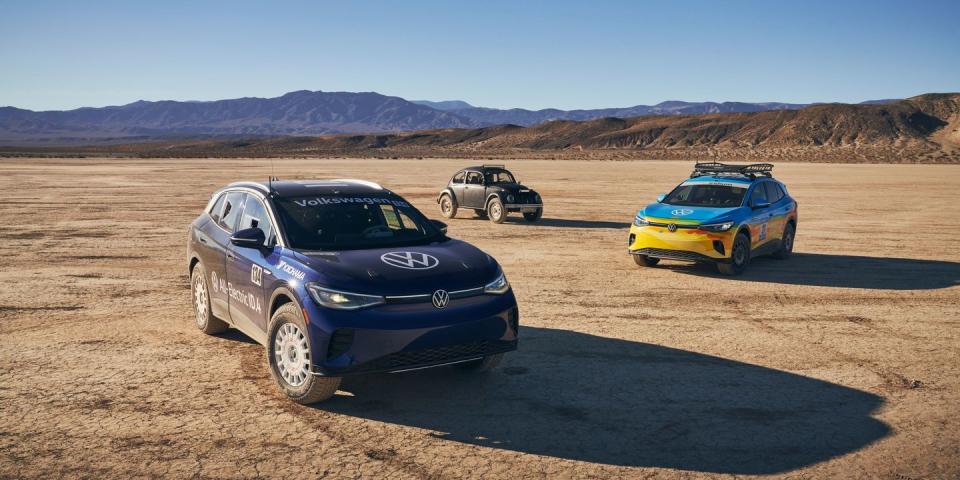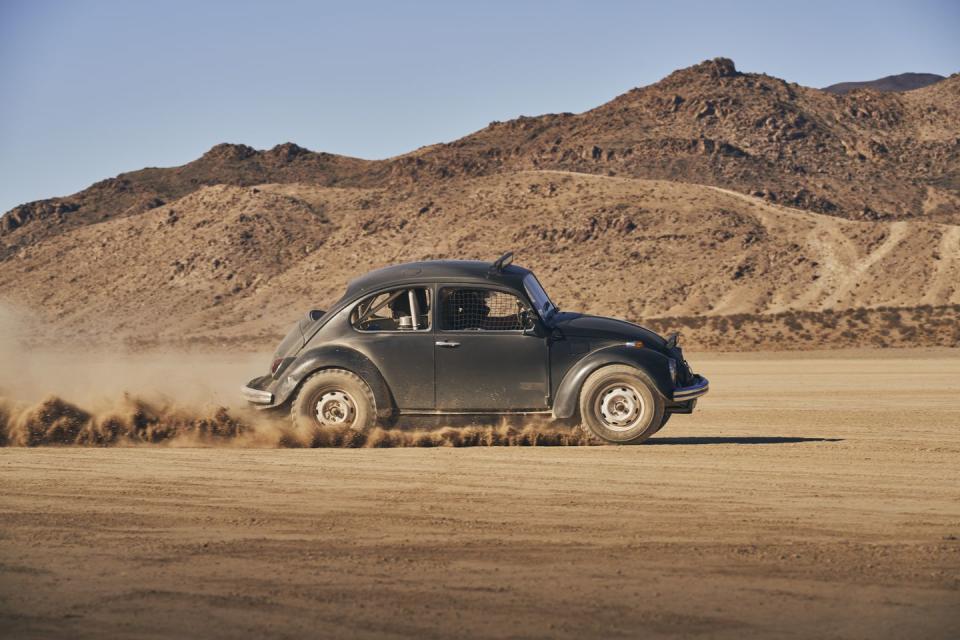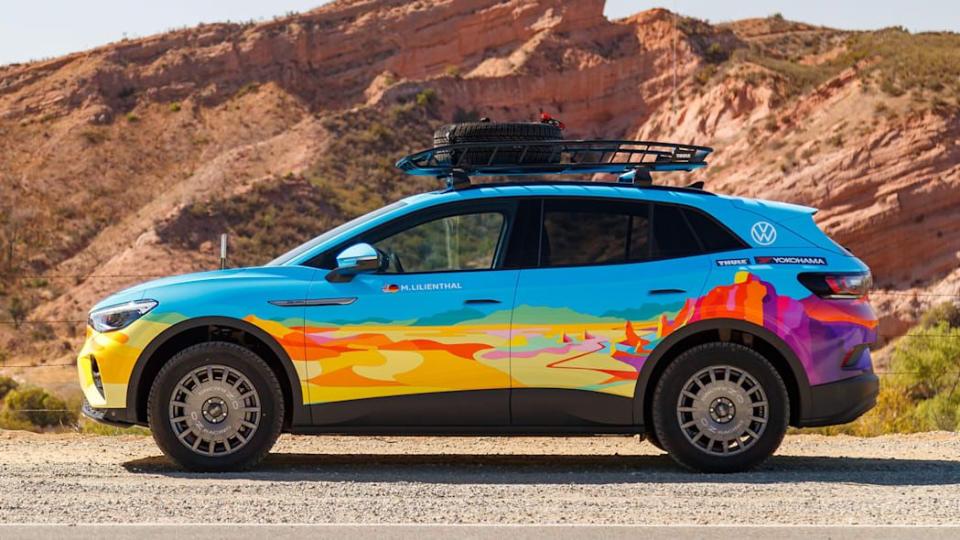Short Drives in VW Desert Racers Past, Present, and Possibly Future

The history of desert racing in the United States and Mexico is in a large part the history of old Volkswagens, specifically, their engines: These air-cooled flat fours powered thousands of race cars from the 1960s through modern times.
“I would guesstimate that the percentage (of Volkswagen engines) today in the sport of desert racing is approximately 40 percent,” said longtime SCORE-International spokesman Dominic Clark. “But in the ‘70s, ‘80s and ‘90s it was as much as 60 percent.”
Indeed, the first winner of the first Baja 1000 (then called the NORRA Mexican 1000) was a VW-powered Meyers Manx, which ran the length of the peninsula from Tijuana to La Paz in 27 hours 38 minutes in 1967. Desert racers fell in love with the Volkswagen mill ever after.
They had a lot to chose from. Volkswagen’s first flat-four was a 1.0-liter unit built in 1936 that made a whopping 24 hp. The company kept developing the powerplant for the next 38 years, topping out with a 2.0-liter version that cranked out 70 screamin’ ponies. While the ancient air-cooled flat-fours officially ended production in 1974, at least for the US market, the racing populous has held them dear ever since. They were cheap, easy to work on, and usually mounted way out on the back of whatever race vehicle they powered, making pendulum turns not only possible but terrific fun.
Volkswagen is aware of this history and keeps a few of these race buggies around, even in this modern era when the company has sworn off internal combustion forever in favor of electric motors starting by 2035 in Europe, their adoption being a little slower for the U.S.

Last week Volkswagen invited us out to Johnson Valley, California, home of King of the Hammers, to drive an old, wheezing Beetle along with two of its modern electric ID.4 variants, both ostensibly set up for racing. The idea was to show the past, present, and probable future of VW off-road racing.
Laid out in the desert dirt ready to roll was a 1969 Class 11 Beetle, a rear-drive ID.4 First Edition, and an all-wheel-drive Pro ID.4, the latter two being electric, the future of Volkswagen.
We got a choice of which car to take out first and went with the 1969 Beetle. It had a race-tuned 1600-cc engine running a 10:1 compression ratio and was fed 110-octane race fuel for an estimate “72-76 hp.” Even considering the race-stripped #1107 weighed just 2150 pounds, the performance was already in a class of its own, albeit a slower class.

The car had been conveniently pre-coated with dirt by numerous earlier runs, and I shimmied into the race bucket and strapped on the five-point belt, already covered with Johnson Valley souvenir dust. My helmet didn’t have the fitting required to utilize the Parker Pumper air filtration system fitted into the car so I’d be eating dust the whole way. (Suck it up buttercup—and cough it out.)
The carbureted engine took a little pumping before it fired, catching best at partial throttle, then wheezing to life with great effort. The four-speed manual was simple enough, and at launch I was even able to spin the rear-driven wheels in a semi-donut.
On the road the first thing I noticed was the genius of Ferdinand Porsche’s design: the driver (me) sat perfectly amidship on the wheelbase between the front and rear axles. Thus, as the craft walloped over whoop-dee-doos, with the front and rear ends swinging wildly up and down, the driver sat in relative comfort, like a first-class ship passenger with a cabin in the middle of the ship. The car itself seemed to use most of its mechanical output to create noise, but some of the estimated 72-76 hp did go to moving it down the road. How drivers in SCORE’s Class 11 did this for 1000 miles was beyond me. Hats off to those guys.
Next I got in the ID.4 First Edition electric car that had been modified for racer/writer Emme Hall and pro driver Tanner Foust to drive in the NORRA Mexican 1000 earlier this year. This car was supposed to have been set up for desert racing with a roll cage, stripped interior, skid plates, appropriately sized 18-inch wheels wrapped with 255/70 R-18 tires and a two-inch lift. The suspension was likewise supposed to be set up for speeding through the dirt.
“Suspension was thoroughly reworked with rally-style coil-over struts at all wheels and tubular lower control arms in the front and boxed lower rear links,” the spec sheet read.

However, if you watch Hall’s account of the NORRA race, the suspension was not very conducive to driving over things like, say, bumps.
“The rear suspension mounts took a dump,” said the ever-eloquent Hall.
Later, I asked her to elaborate on that statement.
“The mounts broke, but they were some kind of Australian crap that Reese (racer Rhys Millen, who had set up the car) put on,” she said. “They were able to swap the stock ones back on for the race. I’m not sure what is on there now.”
Now it felt like the stock shocks, but really, really worn stock shocks. Every moderate-sized bump the ID hit resulted in the rear end sailing skyward then crashing down to the earth. In even moderate whoops I had to creep along at no better than 20 mph lest the whole rig pitchpole forward and roll nose-over-tail. On top of that, both the ID.4 First Edition and the ID.4 AWD PRO I drove next had their traction control systems fully on! Queries to the VW staff resulted in only, “They couldn’t turn it off.” Hence, my whole drive had to take place at a speed appropriate for picking up your kids from preschool.

The setup in the next ride, that ID.4 AWD PRO driven in this year’s Rebelle Rally, was about the same. It rode on stock shocks all around but with “reinforced select suspension arms.” It also sported Kevlar underbody skid plates and Yokohama Geolander A/T tires on Method race wheels. It was essentially a stock ID.4 with a roll cage and better tires. Like the previous ID.4, it had 201 hp and 228 lb-ft of torque from an 82 kWh battery; 201 hp could conceivably be fun in the dirt, but with the constantly intrusive traction- and stability control systems getting in the way, it was really no fun at all to drive.
Pray this is not the future of VW motorsports. Like, are there plans to race more of these?
“There’s nothing planned from HQ in Germany, as far as I know, but we are looking into the possibility of doing some desert racing next year,” said a VW spokesman.
This from the company that is supposed to be going into F1, maybe, and that obliterated the record at Pikes Peak with a purpose-built electric race car? It even took on the Baja 1000 not too long ago with an Audi R8 V10 diesel-powered trophy truck. I expected more. What better way to promote electrification than to build a race car that’s actually fun to drive, maybe even fast? Considering the long history of Volkswagen in desert racing, we should all demand more from Wolfsburg. Who’s with me? Let’s go!
Share your thoughts on desert racing, VW’s legacy in the dirt, and the future of the sport in the comments below.

 Yahoo Autos
Yahoo Autos 